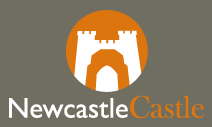Stars and Stripes on Tyne: A History of Famous American Visitors to Tyneside
In this blog, Cathryn takes a look at some of the famous Americans who have visited Tyneside over the years.
Buffalo Bill Cody
The Town Moor is well known for hosting the Hoppings in June each year, in 1904 the entertainment continued into July when a particularly famous American showman arrived in Newcastle. William F Cody, better known as Buffalo Bill, came to the North East as part of a tour of the UK. Born in 1846 in what was then the Iowa Territory, Cody claimed to have held several jobs in his early life including Pony Express rider, stagecoach driver and hotel manager. He served with the Union Army for two years during the American Civil War before being discharged. After the war he returned to the Army as a scout, taking a leave of absence from 1867 to 1868 when he was contracted by the Kansas Pacific Railroad to supply buffalo meat for its workers. In the space of 18 months Cody is estimated to have killed 4282 buffalo giving him his nickname of Buffalo Bill. His showbusiness career began in late 1872 when he performed in The Scouts of the Prairie, a Wild West show produced by Ned Buntline. Buffalo Bill’s Wild West, a circus style attraction which toured annually was founded in 1883, with the show’s name being changed to Buffalo Bill’s Wild West and Congress of Rough Riders of the World in 1893. Several of the show’s performers are well known in their own right, Sitting Bull, Calamity Jane, and Annie Oakley all worked for Cody during their lives, although none performed in the North East. The 1904 tour wasn’t Cody’s first time in the UK, his show had performed for Queen Victoria in 1887 as part of her Golden Jubilee celebrations. Over 140,000 are said to have attended the 12 performances given in Newcastle between the 11th and 16th July 1904. As well as Newcastle the show also performed in Sunderland, North Shields, and South Shields. Cody died in Denver in 1917.
Martin Luther King Jr. in Newcastle University
Perhaps you or someone you know has graduated recently. In 1967, Newcastle University presented a prominent Civil Rights leader with an Honorary Doctorate. Born in Atlanta in 1929, Martin Luther King Jr became a pastor in 1954 for the Dexter Avenue Baptist Church in Montgomery. Although both King and his wife Coretta had been involved in the Civil Rights Movement since their move to Montgomery, he first became prominent in the movement after the Montgomery Bus Boycott. For more than a year between 1955 and 1956, he led and organised the boycott from his office in the church’s basement. The campaign was successful, with the US Supreme Court ruling that segregated transport was unconstitutional. He became the first President of the Southern Christian Leadership Conference (SCLC) in 1957.The group advocated the use of nonviolent civil resistance and gave the Civil Rights Movement a more national platform. It was during his time as the leader of the SCLC that King gave his famous, I Have a Dream speech in August 1963. For his work in leading the Civil Rights Movement, King was awarded the Nobel Peace Prize in 1964, becoming its’ youngest recipient until 2014. On the 13th of November 1967, King travelled to Newcastle University to receive an Honorary Doctorate in Civil Law. Newcastle was the only UK university to honour King in this way during his lifetime, it is also the only city in the UK apart from London that King ever visited. Footage of the ceremony and the impromptu speech given by King can be seen online. Less than five months after his visit to Newcastle, on the 4th of April 1968, Martin Luther King Jr was assassinated in Memphis at the age of 39.
In 1977, Newcastle played host to arguably its’ most prominent American visitor, President Jimmy Carter. Born in 1924 in Plains, Georgia, Carter served in the US Navy from 1946 to 1953, before serving in the Navy Reserve until 1961. He inherited his family’s peanut growing businesses before moving into politics in 1963 when he was elected to the Georgia State Senate. He served as the Governor of Georgia between 1971 and 1975 before being elected as President in 1976. The trip to Newcastle was the first Carter made abroad during his time as President and had the aim of recruiting people to Friendship Force. The organisation had been set up in the March of that year by Carter and Presbyterian minister Wayne Smith with the aim of promoting international cooperation and friendship through stays with local hosts in their homes. The recruitment drive was successful and on the 4th of July the first Friendship Force trips took place with 762 people from Newcastle and Atlanta taking part in an exchange between the two cities. A crowd of 20,000 people gathered at Newcastle’s Civic Centre to see the President, where he gave a speech which famously opened with the well-known Geordie phrase, ‘Howay the Lads.’ After his visit to Newcastle Civic Centre he moved on to the Corning Glass Factory in Sunderland and completed his visit to the North East with a visit to Washington Old Hall, the ancestral home of America’s first President George Washington. After spending around 4 hours in the region Carter made his way to London to attend a summit. After leaving office in 1981, Carter would make a return visit to Newcastle in 1987.
As you can see, Newcastle and the North East has played host to a wide variety of prominent American visitors throughout its’ history.


